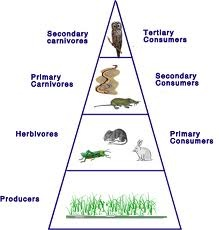Question
Pyramid of numbers in a grassland/tree ecosystem (a) always inverted (b) always upright (c) both (a)...
Pyramid of numbers in a grassland/tree ecosystem
(a) always inverted
(b) always upright
(c) both (a) and (b)
(d) spindle-shaped.
Homework Answers
Answer #1
Answer B: always upright
- Pyramid of numbers represents the total number of individuals of different species (population) at each trophic level.
- In a grassland ecosystem, the number of producers (mainly grasses) is always maximum, followed by decreasing numbers at second trophic level (herbivores), third trophic level (carnivores) and least number of apex predators.

- In this pyramid, the number of individuals is decreased from lower level to higher trophic level.
Not the answer you're looking for?
Similar Questions
Pyramid of numbers in a grassland/tree ecosystem (a) always inverted (b) always upright (c) both (a)...
Pyramid of numbers in a grassland/tree
ecosystem
(a) always inverted
(b) always upright
(c) both (a) and (b)
(d) spindle-shaped.
Pyramid of numbers in a grassland/tree ecosystem (a) always inverted (b) always upright (c) both (a)...
Pyramid of numbers in a grassland/tree
ecosystem
(a) always inverted
(b) always upright
(c) both (a) and (b)
(d) spindle-shaped.
Pyramid of numbers in a grassland/tree ecosystem (a) always inverted (b) always upright (c) both (a)...
Pyramid of numbers in a grassland/tree
ecosystem
(a) always inverted
(b) always upright
(c) both (a) and (b)
(d) spindle-shaped.
Pyramid of numbers deals with number of (a) species in an area (b) individuals in a...
Pyramid of numbers deals with number of
(a) species in an area
(b) individuals in a community
(c) individuals in a tropic-level
(d) subspecies in a community.
True or False a) A converging lens can produce a virtual, upright, enlarged image. b) A...
True or False
a) A converging lens can produce a virtual, upright, enlarged
image.
b) A diverging lens always produces a virtual, upright, reduced
image.
c) For a converging lens an object has to be placed between the
focal point and the lens in order to form a virtual image.
d) A converging lens can never produce a virtual, upright,
reduced image. A converging lens cannot produce a real, inverted
reduced image.
e) A diverging lens can produce a real,...
The dominant second trophic level, in a lake ecosystem, is (a) phytoplankton (b) zooplankton (c) benthos...
The dominant second trophic level, in a lake ecosystem,
is
(a) phytoplankton
(b) zooplankton
(c) benthos
(d) plankton.
Study of inter-relationships between organisms and their environment is (a) ecology (b) ecosystem (c) phytogeography (d)...
Study of inter-relationships between organisms and their
environment is
(a) ecology
(b) ecosystem
(c) phytogeography
(d) ethology.
If you can't answer all four, then please answer c and d. Try to answer mathematically....
If you can't answer all four, then please answer c and d. Try to
answer mathematically.
If each statement below is true, prove the statement. If not
true, explain why not.
a) The image of an object reflected by a convex spherical mirror is
always upright and virtual.
b) If an object is placed in front of a converging lens, the
image is always inverted and real.
c) The image of an object reflected through a diverging lens
will always...
On an EKG, AV Nodal Block is indicated by: A. inverted P-wave B. flat T-wave C....
On an EKG, AV Nodal Block is indicated by:
A. inverted P-wave
B. flat T-wave
C. prolonged PR-Interval
D. enlarged R-wave
E. inverted QRS wave
A square pyramid has vertices at A (1,0,0), B (0,1,0), C (-1,0,0) and D (0,-1,0) and...
A square pyramid has vertices at A (1,0,0), B (0,1,0), C
(-1,0,0) and D (0,-1,0) and E (0,0,-1).
Find the angle between the face ABE and the base.
Find the angle between the faces ABE and ADE.
ADVERTISEMENT
Need Online Homework Help?
Get Answers For Free
Most questions answered within 1 hours.
ADVERTISEMENT
Active Questions
asked 9 minutes ago
asked 18 minutes ago
asked 21 minutes ago
asked 22 minutes ago
asked 30 minutes ago
asked 36 minutes ago
asked 40 minutes ago
asked 44 minutes ago
asked 45 minutes ago
asked 48 minutes ago
asked 1 hour ago
asked 1 hour ago
